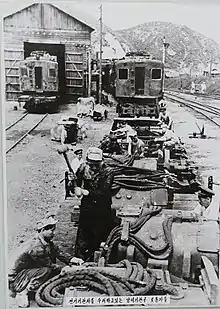| Chosen Government Railway DeRoNi class (デロニ) Korean State Railway Chŏngidu class (전기두) | |||||||||||||||||||||||||||||||||||||||||||||||||||||
|---|---|---|---|---|---|---|---|---|---|---|---|---|---|---|---|---|---|---|---|---|---|---|---|---|---|---|---|---|---|---|---|---|---|---|---|---|---|---|---|---|---|---|---|---|---|---|---|---|---|---|---|---|---|
 A Chŏngidu class locomotive of the Korean State Railway | |||||||||||||||||||||||||||||||||||||||||||||||||||||
| |||||||||||||||||||||||||||||||||||||||||||||||||||||
| |||||||||||||||||||||||||||||||||||||||||||||||||||||
| |||||||||||||||||||||||||||||||||||||||||||||||||||||
| |||||||||||||||||||||||||||||||||||||||||||||||||||||
The DeRoNi-class (Japanese: デロニ) was a group of four boxcab-style electric locomotives with regenerative braking and the capability for multiple-unit control manufactured by Hitachi in 1943-44,[1] very similar to the Toshiba-built DeRoI and the Mitsubishi-built DeRoI-class locomotives.[2]
They were built for the Chosen Government Railway (Sentetsu), who designated them DeRoNi (デロニ) class, and after the partition of Korea were inherited by the North Korean State Railway, where they were known as the Chŏngidu (Korean: 전기두, "Electric 2") class.[3]
Description
The Government-General of Korea began working on a national electric power policy in November 1926, and the resulting plan was completed in December 1931. Chapter 4, "Utilising Electricity in Transportation in Korea" dealt with the electrification of Korea's railways. In 1937, a plan to electrify the Bokgye–Gosan section of the Gyeongwon Line, the Jecheon–Punggi section of the Gyeonggyeong Line and the Gyeongseong–Incheon Gyeongin Line was submitted to the Imperial Diet, which approved it in 1940.[4] The Railway Bureau began implementation of the plan in 1938,[5] and subsequently placed orders with Mitsubishi, Toshiba and Hitachi for 26 electric locomotives.[6]
Sentetsu's order placed with Hitachi was for six electric locomotives intended for operation on the planned electrification of the Gyeongwon and Gyeonggyeong lines - four for the former and two for the latter.[7] Of these, a total of four were delivered by war's end, 2 each in 1943 and 1944; these were designated DeRoNi class (デロニ) by Sentetsu,[4] and numbered デロニ1 through デロニ4.[8]
This class name, デロニ (DeRoNi), comes from the Sentetsu classification system for electric locomotives: DeRoNi = De, for "electric" (from 電気, denki), Ro, to indicate six powered axles (from Japanese roku, 6), and Ni (from Japanese ni, 2), indicating the second class of electric locomotive with six powered axles.[8]
Though generally quite similar in appearance to the DeRoI-class locomotives, there were a number of features that distinguished the DeRoNi class from those. These were: equally spaced side windows; a distinctive ventilator shape; a distinctive arrangement of the deck railings; three-point electrical connectors mounted vertically at the centre of the end decks like on Soviet VL19 class; they were slightly longer and slightly more streamlined than the DeRoI locomotives.[9]
After the end of the Pacific War, at the time of the partition of Korea, all four of the DeRoNi locomotives remained in the North. These were operated on the Kosan-Pokkye segment of Kangwŏn Line prior to the Korean War.[10] As the Korean War caused the destruction of the electrification of North Korea's rail lines, they sat disused until 1956, when they were reclassified Chŏngidu (전기두) class and numbered 전기두1 through 전기두4. They were then refurbished at the engine shops at Yangdŏk for use on the Yangdŏk-Ch'ŏnsŏng section of the P'yŏngra Line, which had been electrified in 1956 as the first stage of North Korea's electrification plans.[11]
Originally painted brown, they were repainted in 1958-1959 in the light blue over dark green livery to match the scheme that was made standard with the introduction of the Red Flag 1 class electric locomotives.[3][8]
No information on the subsequent disposition of these locomotives is available at present.
Gallery
 デロニ1 as built in 1943.
デロニ1 as built in 1943. Another view of デロニ1 in 1943.
Another view of デロニ1 in 1943. Refurbishment of DeRoI and DeRoNi class locomotives at Yangdŏk in 1956.
Refurbishment of DeRoI and DeRoNi class locomotives at Yangdŏk in 1956.
References
- ↑ "デロイを探せ!(その33) 日立評論1944年1月号のデロニ". ゴンブロ!(ゴンの徒然日記) (in Japanese). 19 July 2012.
- ↑ "デロイを探せ!(その2)". ゴンブロ!(ゴンの徒然日記) (in Japanese). 21 October 2011.
- 1 2 Hayato, Kokubu, 将軍様の鉄道 (Shōgun-sama no Tetsudō), ISBN 978-4-10-303731-6
- 1 2 Byeon, Seong-u (1999). 한국철도차량 100년사 [Korean Railways Rolling Stock Centennial] (in Korean). Seoul: Korea Rolling Stock Technical Corp.
- ↑ "松田新市三菱電機技師の戦中戦後の電気車設計". 北山敏和の鉄道いまむかし (in Japanese).
- ↑ "デロイを探せ!(その4)発注数量と実生産数". ゴンブロ!(ゴンの徒然日記) (in Japanese). 3 November 2011.
- ↑ "(untitled)". ゴンブロ!(ゴンの徒然日記) (in Japanese). Archived from the original on 2016-01-16.
- 1 2 3 "デロイを探せ!(その31) 戦後のデロイ(1964年)". ゴンブロ!(ゴンの徒然日記) (in Japanese). 8 July 2012.
- ↑ "デロイを探せ!(その21) 北朝鮮に残るデロイは東芝製?". ゴンブロ!(ゴンの徒然日記) (in Japanese). 6 January 2012.
- ↑ "デロイを探せ!(その46) デロニの動画発見(改)". ゴンブロ!(ゴンの徒然日記) (in Japanese). 12 July 2013.
- ↑ "デロイを探せ!(その22) 北朝鮮のデロイ資料2(交通新聞1956年)". ゴンブロ!(ゴンの徒然日記) (in Japanese). 12 January 2012.